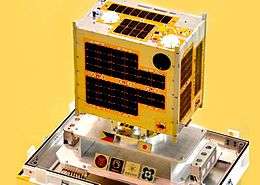Maya-1
| Mission type | Technology demonstration |
|---|---|
| Website |
birds2 phl-microsat |
| Spacecraft properties | |
| BOL mass | 1.11 kg (2.4 lb) |
| Dimensions | 10 x 10 x 11.35 cm |
| Start of mission | |
| Launch date | 09:42, June 29, 2018 (UTC) |
| Rocket | Falcon 9 Full Thrust |
| Launch site | Cape Canaveral SLC-40 |
| Contractor | SpaceX |
| Deployed from | ISS |
| Deployment date | August 10, 2018 |
| Orbital parameters | |
| Regime | Low Earth |
| Inclination | 51.6°[1] |
| |
Maya-1 is a Filipino nanosatellite. Developed under the Philippine Scientific Earth Observation Microsatellite program (jointly implemented by the University of the Philippines and the Department of Science and Technology) and the Kyushu Institute of Technology-led multinational 2nd Joint Global Multination Birds Project (Birds-2), Maya-1 is the first nanosatellite of the Philippines.
Background
Following the launch of the Diwata-1 microsatellite, the Philippine Department of Science and Technology (DOST) announced on June 29, 2017 that two CubeSats or nanosatellites will be launch in 2018. The government agency said that Filipino graduate students, Joven Javier and Adrian Salces attending Kyushu Institute of Technology were working on developing a satellite with their mentors which at that time was still to be named.[2]
The satellite, later dubbed as Maya-1 was developed mainly through the second Joint Global Multination Birds Project (Birds-2) initiated by the Kyushu Institute of Technology (Kyutech) in Japan.[3] The project is managed by a team composed of 11 graduate students from Bhutan, Japan, Malaysia, and the Philippines.[4] The two other satellites developed under Birds-2; BHUTAN-1 of Bhutan and UiTMSAT-1 of Malaysia. The first iteration of the project (Birds-1) was a joint effort by Bangladesh, Ghana, Japan, Mongolia, and Nigeria.[5]
The project was also placed under the Philippine Scientific Earth Observation Microsatellite program (PHL-Microsat).[3] The PHL-Microsat team suggested the name of the satellite which is a local term for a bird in the Philippines.[5]
Development
The Birds-2 project commenced in November 2016.[6] Maya-1 was designed by PHL-Microsat scholars and Kyutech graduate students Joven Javier and Adrian Salces. Javier is pursuing a masters degree while Salces is pursuing a doctorate degree.[7]
Javier, who is also the overall Project Manager of Birds-2, served as the Electronics PCB Designer of Maya-1 while Salces was responsible for developing the satellite's Ground Station Segment and Communication Subsystem.[8]
The satellite which is classified as a 1U CubeSat. [6] It measures 10 x 10 x 11.35 cm and weighs 1.11 kg (2.4 lb).[1] Maya-1 took a year and three months to build.[3]
Instruments
Maya-1 was built using components which are commercially available which was determined safe to use in space. The satellite, along with BHUTAN-1 and UiTMSAT-1, is equipped with Automatic Packet Radio Service Digipeaters. This equipment will be used to demonstrate communication relay capabilities of the three satellites. Maya-1 is also equipped with a Global Positioning System chip and a magnetometer, the latter to be used in measuring magnetic fields in space.[4]
Launch and mission
Maya-1 was launched to space on June 29, 2018 via the Falcon 9 Full Thrust rocket at Cape Canaveral in Florida, United States as part of the SpaceX CRS-15 Commercial Resupply Service mission. BHUTAN-1 and UiTMSAT-1 which were also developed under the Birds-2 project was also among the payload of the rocket.[7] Maya-1, along with the two other satellites were deployed[9] from the International Space Station (ISS) on August 10, 2018 through the space station's Kibo module. It orbits approximately the same altitude of the ISS at about 400 km (250 mi). A few days after its deployment, amateur ground stations from 10 participating nations of the Birds project will confirmed communication with the three satellites.[10]
While built solely by Filipinos, the satellite will be jointly controlled and operated by the Philippines, Bhutan, and Malaysia.The combined cost to build and launch Maya-1 is around $150,000 (₱8 million)[3]
The mission of Maya-1 is for "experimentally testing of commercial apparatus" and due to its size, "a cost-effective educational platform" to help Filipinos build future satellites. The satellite could also be used to relay messages in the event typhoons render cellular services unavailable.[4]The satellite will be operational from about six months[10] to about a year.[10]
References
- 1 2 "Joint Global Multi Nation BIRDS 2(BIRDS 2 Satellite Project)」 衛星の完成について" [Joint Global Multi Nation BIRDS 2 (BIRDS 2 Satellite Project): The Completion of the Satellites] (PDF) (in Japanese). Kyushu Institute of Technology. 26 February 2018. Retrieved 4 July 2018.
- ↑ Usman, Edd (30 June 2017). "After micro-satellite, DOST set to launch 'cube satellites' in 2018". Newsbytes. Retrieved 4 July 2018.
- 1 2 3 4 "Maya-1: Cube satellite latest Pinoy venture into space". Philippine Daily Inquirer. 1 July 2018. Retrieved 4 July 2018.
- 1 2 3 Sabillo, Kristine (29 June 2018). "SpaceX brings Philippines' Maya-1 cube satellite to ISS". ABS-CBN News (in English and Filipino). Retrieved 4 July 2018.
- 1 2 Francisco, Mikael Angelo (1 July 2018). "Space To Excel: Why The First Pinoy-Made Cube Satellite Matters". FlipScience. Retrieved 4 July 2018.
- 1 2 Palden, Tshering (30 June 2018). "BHUTAN-1 leaves for space". Kuensel. Retrieved 4 July 2018.
- 1 2 Panela, Shaira (29 June 2018). "Philippines launches 1st CubeSat into space". Rappler. Retrieved 4 July 2018.
- ↑ Francisco, Mikael Angelo (2 July 2018). "Maya-1 cubesat launch signals next phase of Pinoy space exploration". GMA News. Retrieved 4 July 2018.
- ↑ "ICYMI: Maya-1, Philippines' first cube satellite, is already deployed in its orbit in space!". Twitter. DOST-PCIEERD. 10 August 2018. Retrieved 10 August 2018.
- 1 2 3 "PHL's Maya-1 CubeSat to be deployed from International Space Station on August 10". BusinessMirror. 9 August 2018. Retrieved 10 August 2018.
.jpg)
